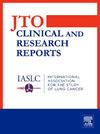Impact of Immune Checkpoint Inhibitors and Local Radical Treatment on Survival Outcomes in Synchronous Oligometastatic NSCLC
IF 3.5
Q2 ONCOLOGY
引用次数: 0
Abstract
Introduction
The impact of an immune checkpoint inhibitor (ICI)–based systemic treatment strategy with or without local radical treatment (LRT) on outcomes for patients with NSCLC and synchronous oligometastatic disease (sOMD) is unknown.
Methods
Multicenter retrospective study including adequately staged patients, with sOMD NSCLC (maximum five metastases in three organs [European Organization for Research and Treatment of Cancer definition]) between January 1, 2015 and December 31, 2022, treated with a first-line ICI-based versus chemotherapy-only regimen. Primary end points were progression-free survival and overall survival (OS) for an ICI-based versus chemotherapy-only strategy. Subgroup analyses were performed for patients who were deemed candidates for LRT in the multidisciplinary meeting and those proceeding to LRT.
Results
A total of 416 patients were included, treated with chemotherapy-ICI (n = 138) or chemotherapy-only (n = 278), 319 out of 416 were deemed candidates by multidisciplinary meetings for LRT, whereas 192 (60%) proceeded to LRT. The median OS was significantly longer in the chemotherapy-ICI compared with the chemotherapy-only group (33.6 versus 15.9 mo, hazard ratio [HR] = 0.5, 95% confidence interval [CI]: 0.4–0.7, p < 0.001), in the subgroups who were candidate for LRT (36.1 versus 17.2 mo, HR = 0.5, 95% CI: 0.4–0.7, p < 0.001) and those proceeding to LRT (not reached versus 23.1 mo, HR = 0.4, 95% CI: 0.2–0.7, p < 0.001). In multivariate analysis, an ICI-based strategy was associated with improved survival in the total group (HR = 0.6, 95% CI: 0.4–0.9, p < 0.001), in those with intention of LRT (HR = 0.6, 95% CI: 0.4–0.9, p = 0.02) and those who proceeded to LRT (HR = 0.3, 95% CI: 0.1–0.6, p = 0.002).
Conclusions
An ICI-based systemic treatment strategy (±LRT) is associated with improved survival compared with chemotherapy-only (±LRT) for patients with sOMD NSCLC. Prospective randomized trial data are necessary to identify patients most likely to benefit from adding LRT.
免疫检查点抑制剂和局部根治治疗对同步少转移性非小细胞肺癌生存结局的影响
基于免疫检查点抑制剂(ICI)的全身治疗策略加或不加局部根治性治疗(LRT)对非小细胞肺癌和同步寡转移性疾病(sOMD)患者预后的影响尚不清楚。方法:采用多中心回顾性研究,纳入2015年1月1日至2022年12月31日期间的sOMD非小细胞肺癌(3个器官最多5个转移灶[欧洲癌症研究和治疗组织定义])患者,接受一线基于ci与仅化疗方案的治疗。主要终点是基于ci与单纯化疗的无进展生存期和总生存期(OS)。对在多学科会议上被认为是LRT候选人的患者和正在进行LRT的患者进行亚组分析。结果共纳入416例患者,分别接受化疗联合ici (n = 138)或单纯化疗(n = 278),其中319例被多学科会议认为是LRT的候选人,192例(60%)进行了LRT。与单纯化疗组相比,化疗联合ici组的中位生存期明显更长(33.6个月vs 15.9个月),风险比[HR] = 0.5, 95%可信区间[CI]: 0.4-0.7, p <;0.001),在LRT候选亚组中(36.1 vs 17.2个月,HR = 0.5, 95% CI: 0.4-0.7, p <;0.001)和进行LRT(未达到vs . 23.1个月,HR = 0.4, 95% CI: 0.2-0.7, p <;0.001)。在多变量分析中,基于CI的策略与总组生存率的提高相关(HR = 0.6, 95% CI: 0.4-0.9, p <;0.001),有意进行LRT的患者(HR = 0.6, 95% CI: 0.4-0.9, p = 0.02)和进行LRT的患者(HR = 0.3, 95% CI: 0.1-0.6, p = 0.002)。结论与单纯化疗(±LRT)相比,基于ci的全身治疗策略(±LRT)可提高sOMD NSCLC患者的生存率。需要前瞻性随机试验数据来确定最有可能从添加LRT中获益的患者。
本文章由计算机程序翻译,如有差异,请以英文原文为准。
求助全文
约1分钟内获得全文
求助全文
来源期刊

JTO Clinical and Research Reports
Medicine-Oncology
CiteScore
4.20
自引率
0.00%
发文量
145
审稿时长
19 weeks
 求助内容:
求助内容: 应助结果提醒方式:
应助结果提醒方式:


